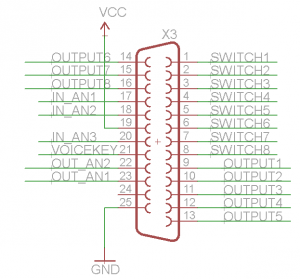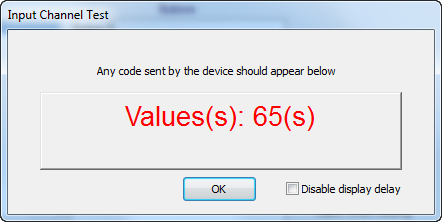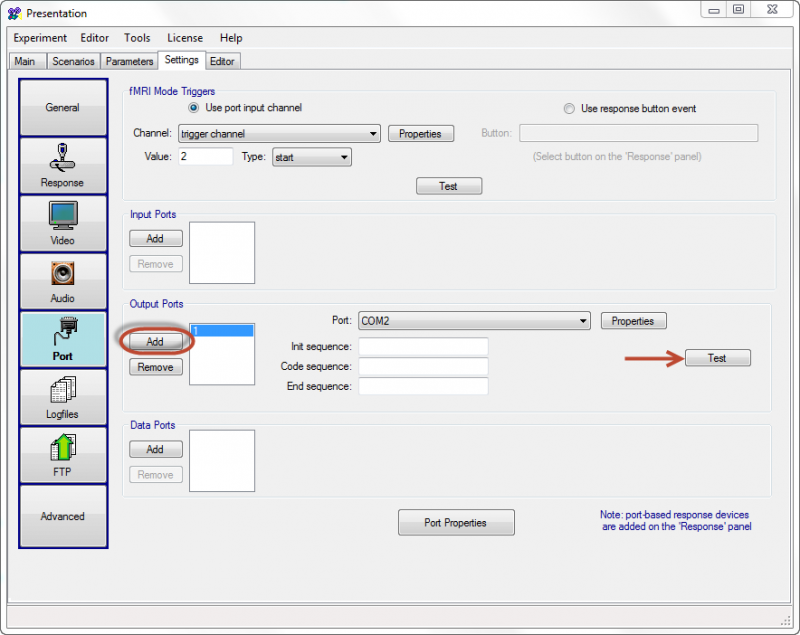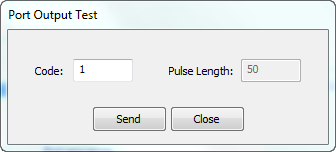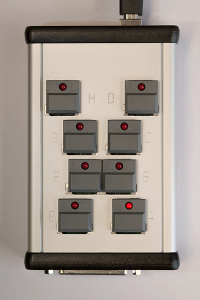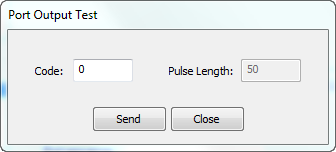Difference between revisions of "ButtonBoxes"
Wiki-admin (talk | contribs) |
Wiki-admin (talk | contribs) |
||
| Line 339: | Line 339: | ||
% | % | ||
% to run: (receiving incoming data, check code for own purposes) | % to run: (receiving incoming data, check code for own purposes) | ||
| − | % buttonbox('run' | + | % buttonbox('run'); |
% | % | ||
% or | % or | ||
| Line 353: | Line 353: | ||
% | % | ||
% to close the connection: | % to close the connection: | ||
| − | % buttonbox('close' | + | % buttonbox('close'); |
| − | |||
| − | |||
| + | persistent old_hdl % keep handle to COM object persistent | ||
% set defaults | % set defaults | ||
bb.Device = 'COM2'; | bb.Device = 'COM2'; | ||
| Line 362: | Line 361: | ||
bb.DataBits = 8; | bb.DataBits = 8; | ||
bb.StopBits = 1; | bb.StopBits = 1; | ||
| − | bb.Parity = 'none'; | + | bb.Parity = 'none'; |
| − | |||
if nargin < 1 | if nargin < 1 | ||
cmd = 'open'; | cmd = 'open'; | ||
| Line 379: | Line 377: | ||
end | end | ||
| + | if ~any(strcmp(cmd,{'open','close'})) | ||
| + | if isempty(old_hdl) | ||
| + | help serial_buttonbox_common | ||
| + | error('Buttonbox not yet initialized'); | ||
| + | end | ||
| + | handle = old_hdl; | ||
| + | end | ||
switch cmd | switch cmd | ||
case 'marker' | case 'marker' | ||
| − | + | fwrite(handle, uint8(marker));%IOPort('Write', handle, uint8(marker), 1); % last argument: blocking | |
| − | + | WaitSecs(0.002); | |
| − | + | fwrite(handle, uint8(0));%IOPort('Write', handle, uint8(0), 0); % last argument: blocking | |
| − | |||
| − | |||
| − | |||
| − | |||
| − | IOPort('Write', handle, uint8(0), 0); % last argument: blocking | ||
| − | |||
| − | |||
| − | |||
return | return | ||
case 'clear' | case 'clear' | ||
| − | + | while(handle.BytesAvailable) | |
| − | + | fread(handle, 1); | |
| − | + | end | |
| − | end | ||
| − | |||
| − | |||
ret = []; % meaningless | ret = []; % meaningless | ||
return | return | ||
| Line 409: | Line 403: | ||
return | return | ||
case 'close' | case 'close' | ||
| − | if nargin > | + | if nargin > 1 |
handle = varargin{1}; | handle = varargin{1}; | ||
else | else | ||
| Line 415: | Line 409: | ||
end | end | ||
fclose(handle); | fclose(handle); | ||
| − | ret = | + | delete(handle); |
| + | ret = []; | ||
return | return | ||
case 'run' | case 'run' | ||
% read incoming data | % read incoming data | ||
| − | |||
| − | |||
| − | |||
| − | |||
| − | |||
% code proceeds below .... | % code proceeds below .... | ||
case 'wait_keypress' | case 'wait_keypress' | ||
| − | + | % start polling for characters (indicating start of scan) | |
| − | + | while(1) | |
| − | + | data = []; | |
| − | + | while handle.BytesAvailable | |
| − | + | navailable = handle.BytesAvailable; | |
| − | + | % read incoming data | |
| − | + | [newdata, cnt] = fread(handle, navailable); | |
| − | + | % concatenate possible new data | |
| − | + | if cnt | |
| − | + | data = [data newdata(:)]; | |
| − | |||
| − | |||
| − | |||
| − | |||
| − | |||
| − | |||
| − | |||
| − | |||
| − | |||
| − | |||
end | end | ||
| + | end | ||
| + | if ~isempty(data) | ||
ret = data; | ret = data; | ||
return | return | ||
end | end | ||
| − | end | + | end |
otherwise | otherwise | ||
fprintf('Unknown option %s\n',cmd); | fprintf('Unknown option %s\n',cmd); | ||
ret = []; | ret = []; | ||
| − | return | + | return |
| − | + | end | |
| − | |||
| − | end | ||
%%%%%%%%%%%%%%%%%%%%%%%%%%%%%%%%%%% | %%%%%%%%%%%%%%%%%%%%%%%%%%%%%%%%%%% | ||
% only gets here when cmd = 'run' % | % only gets here when cmd = 'run' % | ||
| − | %%%%%%%%%%%%%%%%%%%%%%%%%%%%%%%%%%% | + | %%%%%%%%%%%%%%%%%%%%%%%%%%%%%%%%%%% |
| − | |||
% Initialize output figure | % Initialize output figure | ||
win = list_output(' ',[]); | win = list_output(' ',[]); | ||
| Line 491: | Line 470: | ||
end | end | ||
pause(0.01); | pause(0.01); | ||
| − | end %while 1 | + | end %while 1 |
| + | |||
| + | |||
function hdl = open_buttonbox(device) | function hdl = open_buttonbox(device) | ||
| − | % open handle to serial device (mini buttonbox) | + | % open handle to serial device (mini buttonbox) WaitSecs(0.002); % just to load mex-file into memory |
try | try | ||
hdl = serial(device.Device, 'Baudrate', device.BaudRate, 'DataBits', device.DataBits, 'StopBits', device.StopBits, 'Parity', device.Parity); | hdl = serial(device.Device, 'Baudrate', device.BaudRate, 'DataBits', device.DataBits, 'StopBits', device.StopBits, 'Parity', device.Parity); | ||
| Line 506: | Line 487: | ||
fopen(hdl); | fopen(hdl); | ||
end | end | ||
| − | old_hdl = hdl; | + | old_hdl = hdl; |
| − | |||
fprintf('Wait for device buttonbox....\n'); | fprintf('Wait for device buttonbox....\n'); | ||
tic | tic | ||
| Line 515: | Line 495: | ||
fread(hdl, navailable); | fread(hdl, navailable); | ||
end | end | ||
| − | pause(0.5); | + | pause(0.5); |
| − | + | end | |
| − | |||
| − | |||
| − | |||
| − | |||
| − | |||
| − | |||
| − | |||
| − | |||
| − | |||
| − | end | ||
function win = list_output(line,win) | function win = list_output(line,win) | ||
| Line 532: | Line 502: | ||
persistent lines | persistent lines | ||
persistent edt | persistent edt | ||
| − | Maxlines = 40; | + | Maxlines = 40; |
| − | |||
if isempty(win) | if isempty(win) | ||
% initialize listbox output figure | % initialize listbox output figure | ||
| Line 540: | Line 509: | ||
ptr=Maxlines; | ptr=Maxlines; | ||
lines(ptr) = {'Buttonbox output:'}; | lines(ptr) = {'Buttonbox output:'}; | ||
| − | idxs = mod(ptr:ptr+Maxlines-1,Maxlines)+1; | + | idxs = mod(ptr:ptr+Maxlines-1,Maxlines)+1; |
| − | |||
win = figure(); | win = figure(); | ||
% initialize figure to hold output text | % initialize figure to hold output text | ||
| Line 555: | Line 523: | ||
set(edt,'String',lines(idxs),'Value',Maxlines); | set(edt,'String',lines(idxs),'Value',Maxlines); | ||
drawnow; | drawnow; | ||
| − | end | + | end |
| − | + | end | |
end</syntaxhighlight> | end</syntaxhighlight> | ||
Revision as of 15:51, 11 March 2016
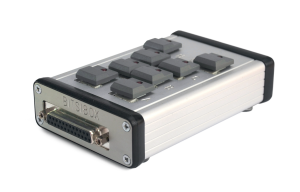 2013 Buttonbox | |
| Downloads | |
|---|---|
The buttonbox is used for time accurate(1ms) button press registration. We use it to register buttonpresses, soundkey, voicekey signals and to send tone onset, analog output, triggers with the BITSI protocol. It is suitable for Behavioral, EEG, MEG, and fMRI experiments. The buttonbox is connected to a computer with a usb connection.
The output connector has two binary eight bit ports: input and output. The two ports can be used for responses (input) and stimulus triggers (output). Two 12 bits analog outputs and three 12 bits analog inputs. The output connector has a sound and voicekey which triggers when a amplitude reaches a threshold. By using the serial port, the BITSI can be used platform independently: it works on Windows, Linux and Mac OSX. Most programming environments and stimulus packages support serial communication.
BITSI Protocol
BITSI stands for Bits to Serial Interface. Because the BITSI is designed to interface both in- and output signals, the 'protocol' is asymmetric: the input and output protocols differ.
Input
The input port can be used to interface eight buttons maximally. Button presses are translated to serial output characters/bytes according to the following table:
| BITSI Simple | ||
|---|---|---|
| Signal/Button | ASCII (rise/fall) | Code (rise/fall) |
| 1 | A / a | 65 / 97 |
| 2 | B / b | 66 / 98 |
| 3 | C / c | 67 / 99 |
| 4 | D / d | 68 / 100 |
| 5 | E / e | 69 / 101 |
| 6 | F / f | 70 / 102 |
| 7 | G / g | 71 / 103 |
| 8 | H / h | 72 / 104 |
This means that when signal 1 gets active(button press), a capital A will be sent to the serial port. A lowercase 'a' will be sent when the signal is deactivated(button release). Mechanical buttons can be connected directly.
Output
Output knows two protocols: BITSI simple or BITSI extended. To enter a certain protocol two buttons have to be pressed when the BITSIbox is powered. Press button H and A for simple mode and H and B for extended mode.
If no button is pressed when powered it boots the last known protocol. In the simple protocol every byte sent to the BITSI over the serial port, is represented at the 8 bit output.
The extended protocol uses two bytes(or two characters), this combination can access two analog outputs and a tone generator. The first byte selects the output. The second byte determines the value written to this output.
| BITSI Extended | ||
|---|---|---|
| Function | Byte 1 (ASCII/code) | Byte 2 |
| Marker Out | M / 77 | Marker Value |
| Pulse Out | P / 80 | Marker Value |
| Pulse Time | X / 88 | ms before pulse reset |
| Analog Out 1 | Y / 89 | Analog Output Value |
| Analog Out 2 | Z / 90 | Analog Output Value |
| Tone | T / 84 | Start Tone |
| Detect Sound | D / | S / 83 |
| Detect Voice | D / | V / 83 |
| Calibrate Sound | C / | S |
| Calibrate Voice | C / | V |
| Analog In 1 | A / | 1 |
| Analog In 2 | A / | 2 |
| Analog In 3 | A / | 3 |
| Analog In 4 | A / | 4 |
| LEDs Off | L / | X |
| LEDs Input | L / | I |
| LEDs Output | L / | O |
Port Settings
Trigger port
The 25 pins female connector has 8 inputs and 8 outputs, respectively 1-8 are inputs and 9-16 are outputs. Three analog input with an analog to digital convertor of 12 bit, pins 17,18,20 and 21. Two analog outputs with an digital to analog convertor of 12 bits on pins 22 and 23.
Serial port
Our hardware design allows to be connected to the computers USB and emulates a serial communication Port.
| Baudrate | 115200 |
| Parity | None |
| Data bits | 8 |
| Stop bits | 1 |
| Flow control | None |
USB-Com port
1.Connect the BITSIbox to your computer using the USB cable.
2.When you connect the BITSIbox, Windows should initiate the driver installation process (if you haven't used the computer with an BITSIbox board before).
3.On Windows Vista/7, the driver should be automatically downloaded and installed.
4.On Windows XP, the Add New Hardware wizard will open:
- When asked Can Windows connect to Windows Update to search for software? select No, not this time. Click next.
- Select Install from a list or specified location (Advanced) and click next.
- Make sure that Search for the best driver in these locations is checked; uncheck Search removable media; check Include this location in the search and browse to the c:/beheer/arduino/drivers directory.
- The wizard will search for the driver and then tell you that a "USB Serial Converter" was found. Click finish.
- The new hardware wizard will appear again. Go through the same steps and select the same options and location to search. This time, a "USB Serial Port" will be found.
How to Check the Com Port settings(important!)
- From the Start menu, open the Control Panel.
- From the control panel, open the System window.
- From the system properties window, go to the Hardware tab and click the Device Manager button.
- From the Device Manager window, click Ports (Com&LPT). You should now be able to see which Com Port the USB adapter is assigned to.
- If the Com Port is 10 or higher, you will have to change it to a lower port.
- From the Device Manager window, click on USB Serial Port (Com#). Click the Port Settings tab of the USB Serial Port Properties window, and then click the Advanced button.
- In the Advanced Settings window, use the scroll input to select a Com Port (select 10 or lower). Change Receive (bytes) and Transmit (bytes) to 64. Change the Latency Timer to 1.
- Click the OK button.
Always connect the usb device to the same port and your settings will be remembered.
Software Settings
Neurobs Presentation
The experiment files needs a few settings for the device to work:
- In the settings tab: port -> input port -> 1 must be the device that identifies itself as "Arduino Uno" in the device manager. Note that the port must have a number not higher than 10 (COM1-COM10). Use re-enumerate if it is higher.
- Rate must be set 115200, Parity to None, Data Bits to 8 and Stop Bits to 1, Uncheck FIFO Interrupt.
Testing Buttonbox
When pressing on the A button within the input channel tester. You will see the following ASCII code.
Adding Marker
Testing Markers (output)
Send code 1 for Button A
Button A will light up.
Send code 0 for clearing.
Example PCL code you can program a handle to send a marker:
#handle: output_port OutputPort = output_port_manager.get_port( 1 );
Example to send a marker:
OutputPort.send_code(100); #create a marker
for more information see chapter 8 in the presentation course by clicking here
Python/PsychoPy
Download this site-package to use the buttonbox: rusocsci
Example using buttons from the buttonbox in Python:
1#!/usr/bin/env python
2
3# import the rusocsci.buttonbox module
4from rusocsci import buttonbox
5
6# make a buttonbox
7bb = buttonbox.Buttonbox()
8
9# wait for a single button press
10b = bb.waitButtons()
11
12# print the button pressed
13print("b: {}".format(b))
Example using markers with the buttonbox in Python:
1#!/usr/bin/env python
2
3# import the rusocsci.buttonbox module
4from rusocsci import buttonbox
5
6# make a buttonbox
7bb = buttonbox.Buttonbox()
8
9# send a marker
10bb.sendMarker(val=100) #This is your marker code, range code 1-255
Example using BITSI extended in Python:
1#!/usr/bin/env python
2
3# import the rusocsci.buttonbox module
4from rusocsci import buttonbox
5
6# make a buttonbox
7bb = buttonbox.Buttonbox()
8
9# select a function
10bb.sendMarker(val=(ord(X))) #select pulse time
11bb.sendMarker(val=2) #set time of dureation pulse to 2ms
12
13bb.sendMarker(val=(ord(M))) #select marker out
14bb.sendMarker(val=115) #set marker value 115
Example using BITSI extended analog read in Python:
1#!/usr/bin/env python
2
3# import the rusocsci.buttonbox module
4import serial
5
6# make a buttonbox
7ser = serial.Serial("COM2", 115200, timeout = 0.10 )
8
9while True:
10 ser.write('A1')
11 ser.flush()
12 x = ser.readline()
13 visual.TextStim(win, text=x).draw()
14
15 # black screen for 1000 ms
16 win.flip()
17
18 key = event.getKeys()
19 try:
20 if key[0]=='escape':
21 break
22 except:
23 continue
Example using the Buttonbox in PsychoPy:
1#!/usr/bin/env python
2
3# import psychopy and rusocsci
4from psychopy import core, visual
5from rusocsci import buttonbox
6
7## Setup Section
8win = visual.Window(monitor="testMonitor")
9bb = buttonbox.Buttonbox()
10text = visual.TextStim(win, "Press a button on the buttonbox")
11
12## Experiment Section
13# show text
14text.draw()
15win.flip()
16# wait for response
17b = bb.waitButtons()
18# show response
19text.setText("you pressed: {}".format(b))
20text.draw()
21win.flip()
22core.wait(5)
23
24## Cleanup Section
25core.quit()
For more documentation click here: http://pythonhosted.org//RuSocSci/index.html
Matlab
1function ret = buttonbox(cmd,varargin)
2% to initialize connection: (omit 2nd argument if defaults apply)
3% define settings as structure with fields:
4% bb.Device = 'COM2';
5% bb.BaudRate = 115200;
6% bb.DataBits = 8;
7% bb.StopBits = 1;
8% bb.Parity = 'none';
9% handle = buttonbox('open',bb)
10%
11% to run: (receiving incoming data, check code for own purposes)
12% buttonbox('run');
13%
14% or
15%
16% to send a marker: (marker: a numeric value)
17% buttonbox(marker)
18%
19% or
20%
21% to wait for a buttonpress:
22% buttonbox('clear'); (make sure buttonbox buffer is emptied)
23% key = buttonbox('wait_keypress')
24%
25% to close the connection:
26% buttonbox('close');
27
28persistent old_hdl % keep handle to COM object persistent
29% set defaults
30bb.Device = 'COM2';
31bb.BaudRate = 115200;
32bb.DataBits = 8;
33bb.StopBits = 1;
34bb.Parity = 'none';
35if nargin < 1
36 cmd = 'open';
37end
38if nargin > 1
39 % user overwrites default settings
40 flds = fields(varargin{1});
41 for n = 1 : numel(flds)
42 bb.(flds{n}) = varargin{1}.(flds{n});
43 end
44end
45if nargin==1 && isnumeric(cmd)
46 marker = cmd;
47 cmd = 'marker';
48end
49
50if ~any(strcmp(cmd,{'open','close'}))
51 if isempty(old_hdl)
52 help serial_buttonbox_common
53 error('Buttonbox not yet initialized');
54 end
55 handle = old_hdl;
56end
57
58switch cmd
59 case 'marker'
60 fwrite(handle, uint8(marker));%IOPort('Write', handle, uint8(marker), 1); % last argument: blocking
61 WaitSecs(0.002);
62 fwrite(handle, uint8(0));%IOPort('Write', handle, uint8(0), 0); % last argument: blocking
63 return
64 case 'clear'
65 while(handle.BytesAvailable)
66 fread(handle, 1);
67 end
68 ret = []; % meaningless
69 return
70 case 'open'
71 % get handle to serial device
72 handle = open_buttonbox(bb);
73 ret = handle;
74 return
75 case 'close'
76 if nargin > 1
77 handle = varargin{1};
78 else
79 handle = old_hdl;
80 end
81 fclose(handle);
82 delete(handle);
83 ret = [];
84 return
85 case 'run'
86 % read incoming data
87 % code proceeds below ....
88 case 'wait_keypress'
89 % start polling for characters (indicating start of scan)
90 while(1)
91 data = [];
92 while handle.BytesAvailable
93 navailable = handle.BytesAvailable;
94 % read incoming data
95 [newdata, cnt] = fread(handle, navailable);
96 % concatenate possible new data
97 if cnt
98 data = [data newdata(:)];
99 end
100 end
101 if ~isempty(data)
102 ret = data;
103 return
104 end
105 end
106 otherwise
107 fprintf('Unknown option %s\n',cmd);
108 ret = [];
109 return
110end
111
112%%%%%%%%%%%%%%%%%%%%%%%%%%%%%%%%%%%
113% only gets here when cmd = 'run' %
114%%%%%%%%%%%%%%%%%%%%%%%%%%%%%%%%%%%
115% Initialize output figure
116win = list_output(' ',[]);
117while 1
118 % Exit if user closed output figure
119 if ~ishandle(win)
120 return
121 end
122 % start polling for characters (indicating start of scan)
123 navailable = handle.BytesAvailable;
124 if navailable
125 data = [];
126 while navailable
127 % read incoming data
128 [newdata, cnt] = fread(handle, navailable);
129 % concatenate possible new data
130 if cnt
131 data = [data newdata(:)];
132 end
133 % check if any more data left
134 navailable = handle.BytesAvailable;
135 end
136 % output info about which button was pressed
137 for n = 1 : numel(data)
138 line = sprintf('incoming: %03d %s',data(n),char(data(n)));
139 list_output(line,win);
140 end
141 end
142 pause(0.01);
143end %while 1
144
145
146
147 function hdl = open_buttonbox(device)
148 % open handle to serial device (mini buttonbox) WaitSecs(0.002); % just to load mex-file into memory
149 try
150 hdl = serial(device.Device, 'Baudrate', device.BaudRate, 'DataBits', device.DataBits, 'StopBits', device.StopBits, 'Parity', device.Parity);
151 fopen(hdl);
152 catch
153 if ~isempty(old_hdl)
154 fclose(old_hdl);
155 delete(old_hdl);
156 end
157 hdl = serial(device.Device, 'Baudrate', device.BaudRate, 'DataBits', device.DataBits, 'StopBits', device.StopBits, 'Parity', device.Parity);
158 fopen(hdl);
159 end
160 old_hdl = hdl;
161 fprintf('Wait for device buttonbox....\n');
162 tic
163 while hdl.BytesAvailable && toc<10
164 navailable = bbox.BytesAvailable;
165 % wait for welcome message device
166 fread(hdl, navailable);
167 end
168 pause(0.5);
169 end
170
171 function win = list_output(line,win)
172 persistent ptr
173 persistent lines
174 persistent edt
175 Maxlines = 40;
176 if isempty(win)
177 % initialize listbox output figure
178 lines = cell(1,Maxlines);
179 [lines(1:end)]=deal({''});
180 ptr=Maxlines;
181 lines(ptr) = {'Buttonbox output:'};
182 idxs = mod(ptr:ptr+Maxlines-1,Maxlines)+1;
183 win = figure();
184 % initialize figure to hold output text
185 edt = uicontrol('Parent',win,'Style','ListBox','HorizontalAlignment','left', ...
186 'Max',Maxlines,'BackgroundColor',[1 1 1],'Visible','on','String',lines(idxs), ...
187 'FontSize',12,'Value',Maxlines);
188 pos = get(win,'Position');
189 set(edt,'Position',[1 1 pos(3) pos(4)]);
190 end
191 ptr = mod(ptr,Maxlines)+1; % start
192 lines{ptr} = line;
193 idxs = mod(ptr:ptr+Maxlines-1,Maxlines)+1;
194 set(edt,'String',lines(idxs),'Value',Maxlines);
195 drawnow;
196 end
197end
198end
